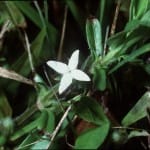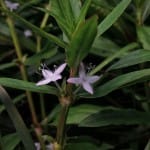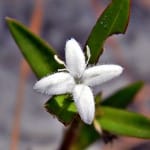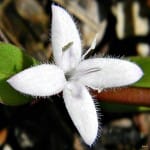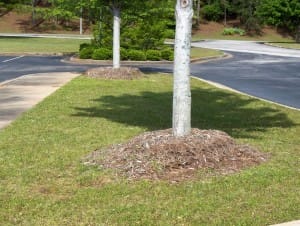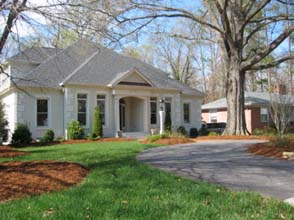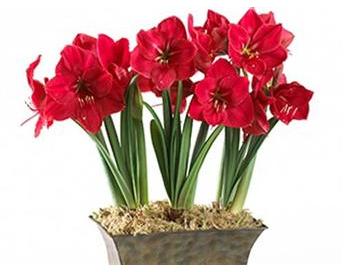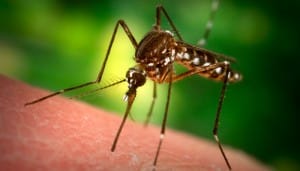Source(s): Kim D. Coder, Professor of Community Forestry, Warnell School of Forestry and Natural Resources, The University of Georgia
Young trees in the landscape, less than three to five years old, require special care to insure establishment and rapid growth. Proper early care helps young trees develop an adequate root system and a strong supportive branch structure. The time and expense invested to train a young tree is much less than treating problems as the tree matures.
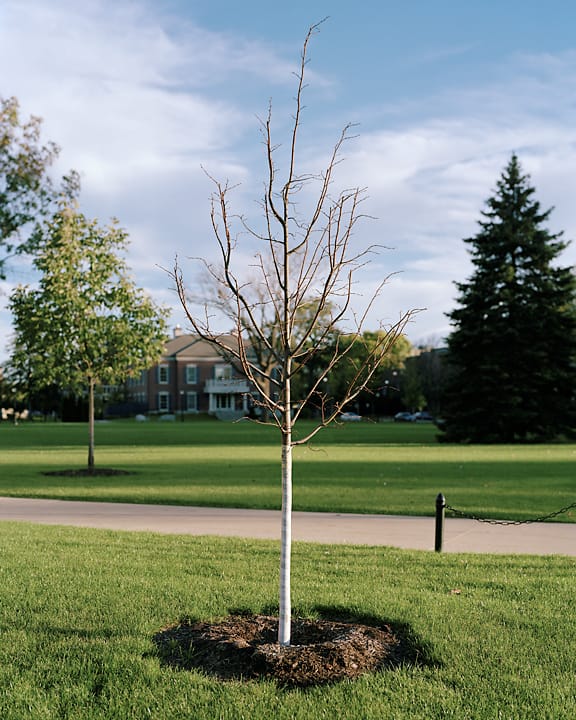
Young trees may require staking, wrapping and corrective pruning. Proper mulching and control of competition can speed growth. In addition, trees require plenty of available water and essential elements for good growth. Young trees need protection from construction activities, lawn mowers and weed eaters, vandals, and pests.
Pruning
Young street and shade trees require proper pruning. Early pruning improves overall structure and corrects branch defects. Early pruning eliminates problems which become severe in middle and old age. Pruning shade and street trees develops and maintains a central dominant leader. Double or co-dominant leaders (forks) should be removed. Select the main leader early and maintain strong side branches. These side branches become the major limbs supporting the weight of the tree later in life. Remove dead, diseased and broken branches. Prune out deformed and crossing branches.
Many side branches should occur singly (alternately) on shade and street trees. However, trees such as ash and maple frequently have major branches occurring in pairs across the main stem. They can be pruned alternately up to 12 to 18 feet. Select and maintain major side branches spaced 24 to 36 inches apart on alternating sides of the stem. Also, select branches with wide angles of attachment, 60 to 90 degrees between the trunk and the branch. remove all waterspouts and basal sprouts.
Staking
Most established young trees can stand alone against wind and not be staked. Young trees with excessively long new shoots or those exposed to windy sites may require staking to remain upright. Stake young trees that are susceptible to blowing over. Anchorage staking holds the roots or root ball stationary until roots become anchored. Use two or three short stakes for anchorage. Extend stakes 12 to 18 inches above the ground. Loop one tie strap loosely around each stake and around the tree trunk. Low attachment prevents root ball dislodgement yet allows the top to move. Staking is temporary. Be sure to check ties frequently.
Support staking aids trees whose trunks are not strong enough to stand upright or fail to return upright. Support the top about six inches above the lowest level at which the trunk can be held and remain upright. This allows top flexibility while providing support. Support the trunk so it can flex without rubbing against the stakes or ties. This must not damage tender bark or girdle the expanding trunk. Support staking holds the tree upright until it can stand alone.
Wrapping
Newly-planted thin bark trees such as red maple or cherries may benefit from wrapping the trunks at planting. Thin barked trees planted on hot sites are very susceptible to sunscald. Commercial tree wraps or plastic tree guards will protect young trees. Spring planted trees can be susceptible to sunburn. The high temperatures from the summer sun may kill the cambium. Tree wraps insulate the cambium.
Young trees may require protection from sunscald. Sunscald occurs when the cambium of thin barked trees heats up during sunny fall or winter days. Colder temperatures that follow warm periods kill cambium cells in the trunk. Long vertical scars run down the trunk from near the lower most branches to the soil line. Injury usually occurs on the southwest side of the trunk. Thin bark maples and cherries, 4 to 5 inches in diameter, may require wrapping in fall to prevent sunscald.
Tree wraps also protect young trees from girdling by rodents. Start at the base of the trunk and wrap up to the lowermost limbs. Overlap each layer one-half inch. Wrap in the fall and leave the tree wrap on throughout the winter and early spring. Tree wrap is temporary and no longer needed once the tree develops corky bark.
Fertilization
Young trees growing in turf areas that are regularly fertilized do not usually require additional fertilization. Trees showing poor growth require a soil test to determine if essential elements are in short supply. When nitrogen is required, fertilize trees by applying 3 pounds of nitrogen per 1000 square feet of area per year. Make two or three applications, one each in April, June and October(optional) at 1 pound of nitrogen per 1000 square feet. Water each site after applying the fertilizer. Fertilizing trees with a turfgrass or groundcover understory requires multiple applications at light rates to avoid injury to the turfgrass or groundcover plants.
Mulching
Mulches aid in the establishment and growth of young trees. They conserve moisture by reducing evaporation from the soil surface. Mulches reduce erosion and water run-off. Mulches reduce competition and compaction. Mulches can effectively reduce summer soil temperatures to create a more favorable root environment. Organic mulches break down and add essential elements to the soil. Do not mulch wet sites, as mulch materials keep soils overly moist by retaining too much soil water.
To improve growth, mulch young trees out beyond the edge of the canopy. Use three to four inches of an organic mulch. Mulches eliminate the need for groundcovers and turfgrasses beneath young trees, thereby reducing competition for essential elements and moisture. Mulching prevents serious injuries to young tree trunks because there is no need to mow or use string-trimmers beneath trees.
Appropriate mulches include pine bark, pine straw and wood chips. Organic mulches more effectively insulate the soil than inorganic or rock mulches. Pull all mulches back from the trunk four to six inches to prevent diseases from invading the trunk. Rodents may live and burrow in loose mulches, so be alert for these pests.
Improving Growth
You can improve young tree growth by following a few basic cultural practices. First, eliminate competition from turfgrasses and groundcovers underneath young trees. Second, mulch beneath the canopy and out beyond the edge of the foliage to improve the root zone environment. Third, surface apply fertilizers directly to the mulched area. Fourth, water during periods of drought. Fifth, keep lawn mowers and string-trimmers away from tree trunks. These steps will improve growth, even on slow-growing trees.
Resource(s):
Center Publication Number: 224
